
Postmodern Decks Beginning With S
This page is part of a larger tarot site. Click here to start at the top.
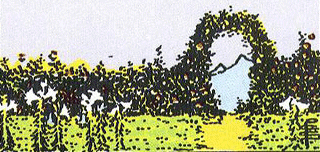
Sacred Circle Tarot. Anna Franklin and Paul Mason. 1999 Llewellyn. - Beautiful photo-collage Celtic pagan deck with very nontraditional majors and Marseilles-style minors.


- A Picture Is Worth 1000 Words - Photographic and Computer Manipulated
- Anna Franklin's Site
- Paul Mason's Site
- David Roell's Review
- Aeclectic Tarot - 4 1/2 stars
- Joan Bunning
- White Rose of Avalon Review
- Review by David Bruce Albert Jr., Ph.D. (doctordruidphd)
Franklin, Anna and Paul Mason. The Sacred Circle Tarot: A Celtic Pagan Journey. 1999: Llewellyn. ISBN 1-56718-457-X (in set with deck)
Tarot of the Saints. Robert Place. 2001 Llewellyn. OOP. - Each Major Arcana and Court card portrays a different saint, and the Minor Arcana use Christian symbols and references to Biblical stories in partially scenic pips. Place's art is elegant, crisp and clear. While this deck is obviously recommended to christo-pagans, those interested in Tarot history and understanding the worldview of those who created the first Tarot decks may wish to pick this set up as well. The book does an excellent job of providing context in this area. The discussion of Pythagorean thought is very well done. As someone interested in meditative tableaux I appreciated the overview of the trumps, as it gives another way of interpreting the septenary tableau from a historical perspective (Joyful, Sorrowful, Glorious).

Place, Robert. A Gnostic Book of Saints. 2001: Llewellyn. ISBN 0-7387-0116-5
- Robert M Place Tarot
- The Alchemical Egg - Robert Place's former site
- Aeclectic Tarot - 4 stars
- Joan Bunning
Santa Fe Tarot. Holly Huber and Tracy LeCocq . 1993 US Games Systems. OOP. - Inspired by Navajo sand paintings. [Rehomed]

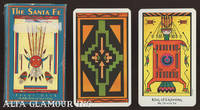

- A Picture Is Worth 1000 Words - Native American
- Holly Huber's web site
- David Roell's Review
- Aeclectic Tarot - 3 stars
- Joan Bunning
- Images of entire deck at Tarot.com
Huber, Holly and LeCocq, Tracy. Santa Fe Tarot. 1997: US Games Systems. ISBN: 0880797568
Secret Tarots. Marco Nizzoli. 1998 Lo Scarabeo - This deck has a story line about a trip through the Land of Secrets including the kingdoms of Pleasure, Richness, Sorrow and Human Work.


- A Picture Is Worth 1000 Words - Rider Waite Theme Clones
- Marco Nizzoli's webpage
- Aeclectic Tarot - 4 stars
- Joan Bunning
Shakespearian Tarot. Dolores Ashcroft-Nowicki and Paul Hardy. 1993 Aquarian/Thorsons. OOP from that publisher but reprinted in 2019 by Datura Press. Sceptres (Wands), Swords, Crowns (Cups) and Orbs (Coins). This deck's meanings are Book T compliant, and the imagery is unique, not attempting to reference RWS.

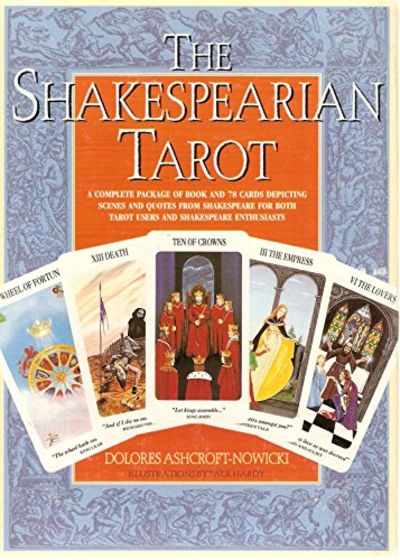
Ashcroft-Nowicki, Dolores. Illustrations by Paul Hardy. The Shakespearian Tarot. 1993: Aquarian/Thorsons. ISBN 1-85538-053-6
- Republished through Datura Press (Dolores Ashcroft-Nowicki's archives are also published through this publisher)
- PDF of my detailed notes on this deck (Card by Card, sorted by Play)
- My deep dive on YouTube
- Dolores Ashcroft-Nowicki (Wikipedia)
- Bio at Immanion Press
- Bio at The Witches Almanac
- The Wild Hunt: Conversations with Dolores Ashcroft-Nowicki (part 1) and Part Two
- Dolores Ashcroft-Nowicki Interview by Grayson Towler and Candi Cooper-Towler
- Paul Hardy
- Aeclectic Tarot - 3 1/2 stars
Shapeshifter Tarot. D.J. Conway and Sirona Knight - Art by Lisa Hunt. 1998 Llewellyn Publications. OOP. - See Valerie Sim-Behi's (at Tarot Passages) and David Roell's reviews. While the style of art is appealing, I have trouble with the notion of shapeshifting depicted (the way everyone is half shifted, split vertically, with one half of human and the other the shifted creature). I really wanted to like the deck, because Lisa Hunt is an excellent artist. But I don't think partnership with Sirona Knight was beneficial in the case of this deck. Combined with the 81 Knights justification for the number of cards in the deck, the ridiculous portrayal of Celtic philosophy, the castrated Sun card, and the overall feel of the deck that is so different from traditional Tarot, the structural issues made it such that I couldn't keep it in my collection. While I personally don't care either way, it's also useful to know that this is one of the recent spate of Wands=Air, Swords=Fire decks.


- A Picture Is Worth 1000 Words - Elvish and Fae
- Lisa Hunt Art website
- D J Conway (1939-2019) wikipedia
- Sirona Knight author page at Llewellyn
- Interview with DJ Conway
- David Roell's Review
- Aeclectic Tarot - 4 stars
- Joan Bunning
Sharman-Caselli. Juliet Sharman-Burke (Author) and Giovanni Caselli (Artist). 2002 Griffin Trade Paperback. - This book and deck set is sold under the title Beginner's Guide to Tarot. Fairly similar to RWS. The art is attractive with pastel coloration and detailed linework. However, it loses the marvelous ambiguity of the scenes in the RWS itself - which can be a disadvantage as it limits the number of possible meanings. For beginners this definition may be an advantage, and for those who think the RWS ugly, this deck belongs on the short list of those to consider. The book should be helpful for beginners, as it points out symbolic elements and explains them, but does not overwhelm with detail.


Sharman-Burke, Juliet. Illustrations by Giovanni Caselli. Beginner's Guide to Tarot. 2002: Griffin Trade Paperback. ISBN 0312284829
- A Picture Is Worth 1000 Words - Rider Waite Close Redrawings
- Juliet Sharman-Burke's page at the Centre for Psychological Astrology
- Aeclectic Tarot - 4 1/2 stars
- David Roell's Review
- Joan Bunning
The Shining Tribe Tarot. Rachel Pollack. 2001 Llewellyn Publications. - "Renewed and Expanded" version of Rachel Pollack’s Shining Woman Tarot, which was originally published in 1992 by Thorson’s
Major Arcana: mostly modern occult titles (Hierophant is Tradition, Wheel is Spiral of Fortune, Hanged Man is Hanged Woman, Judgment is Awakening)
Suits: Trees, Rivers, Birds, Stones
Vision Cards (Court): Place, Knower, Gift, Speaker
Scenic pips mostly readable with RWS-based interpretations
This deck is based on tribal and prehistoric art from around the world. It is called Shining Tribe in honor of the tribe of Tarotists, a tribe "whose roots go back many thousands of years before the actual appearance of Tarot cards. This is the tribe of diviners, those special magicians, shamans, psychics, and visionaries who use cards, or sticks, or trees, or stones, or shells to communicate with the Gods." Like Motherpeace, the coloring is muted, and the unschooled art has a primitive energy that grows on you. Though not conventionally pretty, it has an unusual honesty and depth.
I applaud Rachel’s cultural sensitivity in not repeating exact sacred symbols out of context. "Sacred images often carry the life of a culture. In taking inspiration from these symbols without copying them, I have tried to accept their gifts with great respect to the people who created them."
You definitely want to get the book with the deck. Rachel is such a marvelous storyteller, and this is reason enough to want the book. But imagery and symbolism is all so different from traditional tarot, that without the book, you will probably have no idea what you are looking at.


Pollack, Rachel. The Shining Tribe Tarot: Awakening the Universal Spirit. 2001: Llewellyn. ISBN 1-56718-514-2(came with deck)
The Definitive Edition. 2024: Weiser Books. EAN/UPC 9781578638178
- A Picture Is Worth 1000 Words - Woman Mother Goddess
- Rachel Pollack's site
- Rachel Pollack (1945-2023) wikipedia
- Interview with Rachel Pollack
- David Roell's Review
- Aeclectic Tarot - 3 1/2 stars
The Ship of Fools Tarot. Brian Williams. 2002 Llewellyn. OOP. - Brian's final work was the Ship of Fools Tarot, a tarot deck based on the masterpiece of German literature, Das Narrenschiff (The Ship of Fools) by Sebastian Brant. Brian Williams selects images sometimes based on the topic of the chapter, and sometimes for the similarity of the image to historical tarot (especially with the Major Arcana) or with the Rider-Waite (with the Minor Arcana). This is an ironic tarot, much like his Pomo Tarot. He banters with Brant in his selection of chapters to become tarot cards, often turning Brant's point on its head... Other times, he seems to be making fun of the Rider-Waite image in his selection... Sometimes, the choice Williams made is unexpected, and the divinatory meaning he supplies unlike any I’ve seen before for the card... The accompanying book leaves things to the reader to puzzle out. For each card, Williams usefully provides the Ship of Fools card image, the woodcut from the Narrenschiff, and images of the Marseilles and Rider-Waite cards. In the discussion of the Major Arcana, there is some brief treatment of Renaissance period variants of the card, but not with the same depth as the book accompanying the Renaissance Tarot. For the verses accompanying the woodcut, he provides a translation by Berkeley scholar Peter Spoerl, which is more literal than the verse translation in the more easily accessible Zeydel version that Dover puts out. He describes the various card images shown, but the text really does not justify his choice. That exercise is left to the reader... (from my full length review at Tarot Passages)
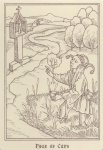
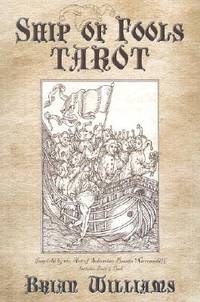
Williams, Brian. The Ship of Fools Tarot. 2002: Llwellyn Worldwide. ISBN: 0738701610 (included with deck)
- A Picture Is Worth 1000 Words - SCA Period
- Brian Williams (1958-2002)
- My review at Tarot Passages (wayback)
- David Roell's Review
- Aeclectic Tarot - 3 1/2 stars
- Joan Bunning
Silicon Valley Tarot. Thomas Scoville. 1998 Steve Jackson Games. - This deck seems as quaint as a raccoon coat now, in the days after the dot com boom has gone crash. An elaborate humor deck, packaged with both oracular meanings and game rules, it captures the flavor of working in a startup. The lack of female perspective included (the only women in the deck are marketers; the High Priestess is a Futurist, the Empress is a Garage). I worked in IT at as a civilian employee of the military, at a university and at a small software startup, though never in the Bay Area. So I have some amount of perspective. Because this deck IS based on the computer geek lifestyle, there are only 70 cards: the pips only go from 1 to 8, as is appropriate in binary numbering. The Major Arcana show the traditional Arabic numeral, and the number in binary as well. The suits are Cubicles, Disks, Hosts, Networks. The LWB does not correlate these to the traditional Tarot suits, but for my own convenience I correlate Cubicles to Pentacles, Disks to Swords, Hosts to Cups, and Networks to Wands. The court cards are Nerds (formerly New Hires), Salesmen, Marketeers, and CIOs.

- A Picture Is Worth 1000 Words - Cold War and Beyond
- Home Page for the print deck at Steve Jackson Games
- Reproduction available at Drive Thru Games
- Home Page of Thomas Scoville
- Silicon Follies a serial comedy by Thomas Scoville
- The Major Arcana: Old Meets New by S. John Ross (at Steve Jackson Games)
- GMTA Someone else's idea for a Silicon Valley I Chingish oracle circa 1999
- Aeclectic Tarot - 3 stars
- Joan Bunning
- Arcadiae Review
- RPGnet Playtest Review by Heather Grove "It's a demented hybrid of Concentration and Black Jack, meant for two to six players."
- Images of all the cards (Version 1.0, before the print version) (at Steve Jackson Games)
Simplified Tarot. Paul De Becker. 1984 AGMüller - Carta Mundi. OOP. (LWB by Jan Bauwens) - Humorous black and white line drawings, with Marseilles-style pips. This is a good deck for carrying in a purse, as it is nice and small. Shy readers may find it useful as a deck for doing readings in public place, as it is unobtrusive to passersby, not shouting out that you are doing a reading the way a small Rider-Waite deck would.

- Aeclectic Tarot - 3 stars
Solleone Tarot. Elisabetta Cassari. 1983 Edizioni Del Solleone (distributed at one time by US Games). OOP. - A very violent, dark and disturbing interpretation of tarot. The quality of the art is excellent, but the subject matter is often very difficult to look at.

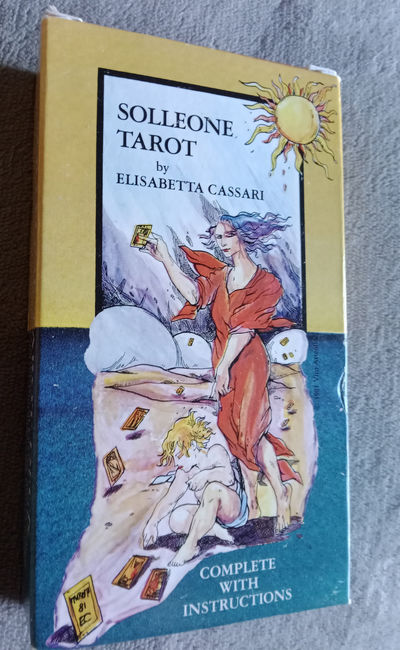
- Mark Filipas' Review
- Aeclectic Tarot - 3 stars
Tarot of the Southwest Sacred Tribes. Violeta Monreal. 1996 US Games Systems. OOP. - A straightforward RWS variation done in the style of Southwestern art drawn from 57 nations, especially Apache, Pueblo, Rio Grande Pueblo, and Navajo.


- A Picture Is Worth 1000 Words - Rider Waite Theme Clones
- A Picture Is Worth 1000 Words - Native American
- Aeclectic Tarot - 3 stars
- Violeta Monreal's site
Spiral Tarot.
By Kay Steventon
US Games Systems, 1997. OOP.
Major Arcana: modern occult titles
Suits: Wands, Cups, Swords, Pentacles
Court: Princess, Prince, Queen, King
Scenic pips readable with RWS-based interpretations
This deck is excellent for studying the Tarot from the perspective of the Journey of the Fool. It is called the Spiral Tarot because that journey is a spiral, not a straight road. The Fool "begins the journey, lives the experience, and comes to the end of that phase only to start afresh. He repeats the process, but like all cycles in nature, the new phase is different from the last." The deck is based on myth, kabbalah and astrology, and mostly uses Golden Dawn correspondences.
The art is gorgeous and deeply dimensional, and the paintings, especially those of the Major Arcana, exude a sense of mystery. The Major Arcana show figures from Middle Eastern, Arthurian and Mediterranean myths, with a higher proportion of Goddesses than is traditional. My favorites are Hestia/Vesta as the Hermit, the Moirae on the Wheel of Fortune, Iris as Temperance, the Triple Goddess Hebe/Hera/Hecate as the Moon, and Eos as the Sun. The Minor Arcana are variations on the RWS deck, depicted in the late 1800’s. The court cards dramatically express the element of their suit.
Hebrew alphabet, elemental and astrological correspondences are depicted on each trump, and basically follow the Golden Dawn scheme. However, she intentionally changed the associations for three cards: 1) as a result of assigning Chiron to the Hierophant, the card does not show Taurus (and neither does any other Major Arcana), but Virgo and Sagittarius, and though it shows the symbol for Chiron, it does not specify an elemental attribution (traditionally Earth) though all the other Major Arcana specify the associated element; 2) Judgment, as a result of being assigned Pluto shows the water triangle rather than the fire triangle, thereby removing the representative of elemental Fire from the scheme; and 3) the World continues to be attributed to Saturn, but apparently loses its dual attribution to elemental Earth, as it shows the Air triangle rather than the Earth triangle.
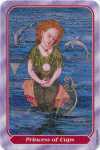


- A Picture Is Worth 1000 Words - Rider Waite Art Twist Decks
- David Roell's Review
- Aeclectic Tarot - 3 1/2 stars
- Joan Bunning
- Images of entire deck at Tarot.com
Steventon, Kay. Spiral Tarot: A Story of the Cycles of Life. 1998: US Games Systems. ISBN: 1572811315
Tarot of the Spirit. Joyce Eakins with handbook by Pamela Eakins. 1992 U.S. Games. - Like Light and Shadow, a true postmodern deck that works esoterically within the Golden Dawn tradition. This one is in color and is quite abstract, but you can still see the Book "T" heritage. By the way, if you are having trouble understanding Book "T" and Crowley's Book of Thoth, the book by Pamela Eakins for Tarot of the Spirit is highly recommended to get you a leg up on the learning curve.



Eakins, Pamela, PhD. Tarot of the Spirit. 1992: Samuel Weiser, York Beach, Maine. ISBN 0-87728-730-9
- A Picture Is Worth 1000 Words - Woman Mother Goddess Tarot Decks
- Mark Filipas's Review
- David Roell's Review
- Aeclectic Tarot - 3 1/2 stars
- Joan Bunning
- Images of entire deck at Tarot.com

This page is part of a larger tarot site. Click here to start at the top.


